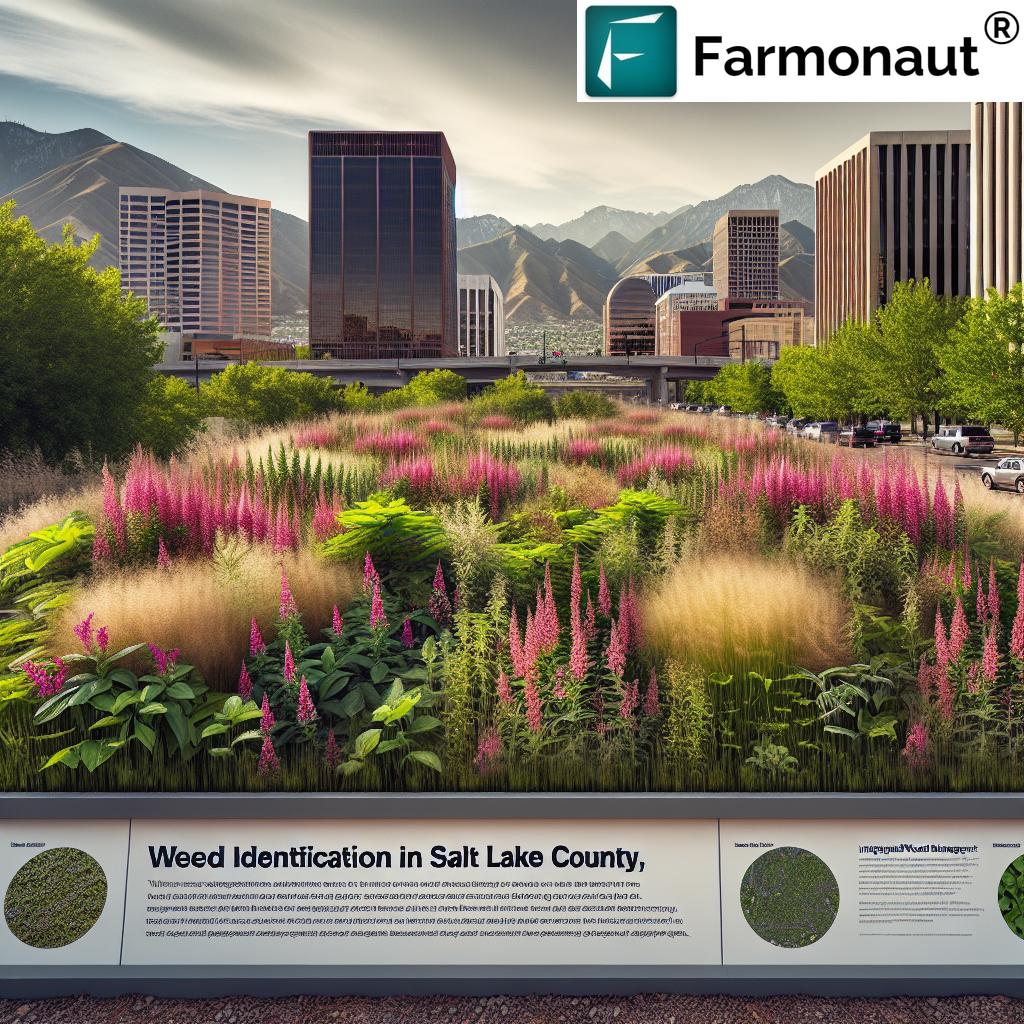Weed Control Salt Lake City: 7 Top Invasive Strategies
“Salt Lake City manages over 30 noxious weed species using seven sustainable control strategies annually.”
Introduction to Weed Control Salt Lake City
Weed control in Salt Lake City is a critical aspect of maintaining productive agriculture, vibrant urban landscapes, and thriving native ecosystems. The region’s unique environmental context—characterized by its semi-arid climate with hot, dry summers and cold, snowy winters—presents both challenges and opportunities for effective weed management.
Understanding the local environment, identifying noxious weeds Utah recognizes as threats, and implementing integrated weed management strategies are essential steps for sustaining healthy and resilient communities.
In this guide, we dive deep into “weed control Salt Lake City” by outlining seven top strategies for combatting invasive species. Together, these approaches support the overarching themes of biodiversity protection, sustainable agricultural practices, and environmental stewardship in Utah.
Understanding the Local Context: Salt Lake City’s Unique Environment
Salt Lake City is situated in the heart of Utah, bordered by the imposing Wasatch Mountains and the expansive Great Salt Lake. This city’s location shapes local microclimates, soil types, and the nature of surrounding agricultural and forested areas. The combination of urban and rural landscapes creates a complex context in which invasive species can rapidly spread, threatening both cultivated and wild ecosystems.
- Semi-Arid Climate: Characterized by hot, dry summers and cold, snowy winters. This significant seasonal variation influences the types and cycles of weed growth.
- Soil Composition: Varying soil types across Salt Lake County—from loamy to clay-rich—affect which weeds thrive in which areas.
- Vegetation Zones: Native plant species are often outcompeted by aggressive invasive weeds, especially in disturbed, irrigated, or nutrient-rich soils.
- Urban & Forested Landscape: The city’s growth into natural and agricultural spaces enables a “corridor effect” for the movement and rapid establishment of invasive weeds.
Effective weed control in Salt Lake City therefore requires methods and strategies that consider this interplay between climate, soil, land use, and human activity.
To support landowners and environmental stewards in addressing these challenges, agencies like the Utah Department of Agriculture and Food (UDAF) have established guidelines for identifying and managing invasive species within this local context.
Weed Identification Salt Lake County: Utah’s Noxious Weeds
The Salt Lake County Noxious Weed Program is at the forefront of combating invasive plant species. The Utah Department of Agriculture and Food (UDAF) designates these plants as “noxious weeds” due to their potential to disrupt agriculture, degrade the environment, and impact public health.
- Leafy Spurge (Euphorbia esula): A tenacious perennial weed, leafy spurge outcompetes native vegetation, releasing chemicals into the soil that suppress other plants.
- Medusahead Rye: Medusahead creates dense mats of tough, wiry growth, displacing native grasslands and increasing fire hazard.
- Purple Loosestrife (Lythrum salicaria): Invades wetlands and riparian zones, crowding out native flora and reducing overall biodiversity.
- Tamarisk: Noted for its high water uptake and flammability, tamarisk alters riparian ecosystems, displaces native plants, and increases fire risk.
- Other Prevalent Invasives: Including field bindweed, yellow starthistle, dyer’s woad, Canada thistle, and Russian knapweed.
The Cooperative Weed Management Areas (CWMAs) across Salt Lake County provide guidance and collaborative resources for weed identification and early detection. Understanding which weeds are noxious is the first step in developing effective management strategies.
“Invasive weeds can reduce native plant diversity by up to 50% in Salt Lake City’s urban green spaces.”
Environmental Impacts of Invasive Plants in Salt Lake City
The environmental impacts of invasive plants in Salt Lake City and throughout Utah are profound and multifaceted:
- Agricultural Losses: Weeds compete with crops for water, light, and soil nutrients, causing direct declines in crop yields and increasing the need for costly interventions.
- Environmental Degradation: Noxious weeds alter soil composition, degrade riparian corridors, and reduce the resilience of local ecosystems to disturbances like drought or wildfire.
- Biodiversity Reduction: Invasive species often outcompete and displace native plants, leading to a loss of native flora and fauna and destabilizing entire ecosystems.
- Fire Hazard: Certain invasives, such as tamarisk and cheatgrass, are highly flammable, increasing wildfire risks throughout the region.
- Water Cycle Disruption: Deep-rooted invasives may lower water tables and disrupt natural hydrological processes.
Recognizing these far-reaching losses is essential for motivating community-wide efforts in invasive species management across public and private lands.
For a deeper technical understanding of how weed invasion disrupts ecosystems, you can explore Salt Lake County’s official resources here.
Weed Control Salt Lake City: 7 Top Invasive Strategies
Effective weed control in Salt Lake City hinges on integrated weed management strategies that combine ecological care with agricultural productivity. By merging traditional and emerging approaches, we can adapt to local climate challenges and leverage innovative technology for sustainable weed management.
1. Mechanical Weed Control Methods
- Mowing: Reduces seed production, keeps foliage in check, and prevents weeds from reaching maturity. Particularly useful in pasture, right-of-ways, and urban green areas.
- Tilling: Physically disrupts weed growth by turning over soil. Effective for annual weeds; less so for deeply rooted perennials. Requires careful timing to avoid soil erosion.
- Mulching: Suppresses weed seed germination by creating a light-blocking layer. Organic mulches enhance soil quality, while synthetic fabrics are suited for certain crops or landscapes.
Mechanical methods provide immediate results and are most effective when integrated with other strategies, especially on small to moderate infestations.
2. Chemical Control (Herbicide Use)
- Selective Herbicides: Target specific weed types while minimizing impact on crops or native flora.
- Non-Selective Herbicides: Used in areas where all vegetation removal is desired, such as industrial sites or before new plantings.
- Best Practices: Always follow label instructions, apply during optimal weather conditions, and adhere to local regulations (view local guidance).
Herbicides should be a last resort or part of an integrated approach to minimize environmental impacts and preserve biodiversity.
3. Biological Control
- Involves introducing natural weed predators or pathogens—such as insects, fungi, or bacteria—that specifically target invasive weeds.
- Caution is essential: All biological agents must be proven non-threatening to non-target species and thoroughly evaluated for unintended consequences.
- Effective for long-term management of certain species (e.g., leafy spurge beetles targeting leafy spurge).
Biological controls are sustainable and self-perpetuating once established, making them an attractive solution for wide-scale invasive species management.
4. Cultural Practices for Weed Suppression
- Crop Rotation: Rotating crops disrupts weed life cycles, preventing species-specific build-up in fields.
- Dense Planting: Planting crops or cover crops at increased densities shades out weeds and increases crop competitiveness.
- Soil Health Management: Healthy, fertile soil supports robust native plant growth and natural weed resistance.
- Native vs Invasive Plant Species: Favor establishment of native species in disturbed sites to restore ecological balance and outcompete invasives.
Employing diverse cultural practices is the backbone of sustainable weed control.
5. Preventing Weed Spread
- Equipment Cleaning: Clean all equipment, vehicles, and shoes after working in infested areas to prevent seeds from spreading.
- Certified Seed and Mulch: Use only weed-free or certified materials to reduce the likelihood of introducing new invasive species.
- Early Detection: Regularly scout and monitor for new infestations. Early removal is more effective and less costly than delayed response.
- Community Education: Teach staff, landowners, and the public about identifying weeds and the need for rapid reporting of new sightings.
Preventive strategies are highly cost-effective and central to invasive species management.
6. Integrated Weed Management Strategies
- Combines multiple control techniques—mechanical, chemical, biological, and cultural—for maximum effectiveness and minimal downside.
- Tailored to specific sites and weed types, taking into account soil, water, crop rotation, and climate conditions unique to the region.
- Prioritizes environmentally-friendly and sustainable weed management practices over strictly chemical or mechanical approaches.
- Relies on ongoing monitoring and adaptability as weather, weed pressure, and best practices evolve in Salt Lake City.
Integrated management is pivotal for long-term weed suppression in Utah’s diverse and dynamic environments.
7. Fire and Water Management in Weed Control
- Fire Management: Certain noxious weeds increase fire hazard by creating dense, dry fuel beds. Removing or reducing these species lowers wildfire risk and protects infrastructure.
- Water Management: Invasive weeds like tamarisk consume excessive amounts of water, reducing resources for native plants and agriculture. Targeted removal and restoration of native riparian species help restore watershed health.
- Promote natural fire regimes and hydrological cycles where appropriate, in consultation with forestry experts and local agencies.
Strategic fire and water management, when applied alongside the above strategies, creates more resilient landscapes and healthier ecosystems.
Comparison Table: Invasive Weed Control Strategies in Salt Lake City
| Strategy Name | Targeted Weed Species | Estimated Effectiveness (%) | Estimated Cost Range (per acre) | Sustainability Rating (1–5) | Brief Environmental Impact Notes |
|---|---|---|---|---|---|
| Mechanical Control (Mowing, Tilling, Mulching) | Annual & some perennial weeds (e.g., leafy spurge, cheatgrass) | 60-80% | $50-$200 | 4 | Low chemical input; potential soil erosion if repeated and poorly timed. |
| Chemical Control (Herbicides) | Most noxious and invasive weeds (e.g., purple loosestrife, Russian knapweed) | 70-95% | $50-$300 | 2 | Potential for drift, water contamination; use with best practices. |
| Biological Control | Specific weeds (e.g., leafy spurge, purple loosestrife) | 40-90% (over years) | $10-$150 | 5 | Ecologically friendly; slow establishment; minimal non-target risk if managed correctly. |
| Cultural Practices | Most weeds, especially annuals | 60-85% | $20-$100 | 5 | Promotes healthy crops and natural weed suppression; improves soil health. |
| Preventive Measures | All noxious and invasive weed species | Up to 100% | $5-$50 | 5 | Least disruptive; highly cost-effective; depends on consistent education and vigilance. |
| Integrated Weed Management | All listed (site-specific) | 80-98% | Variable ($50-$300) | 5 | Balances efficacy, costs, and environmental health; most sustainable long-term. |
| Fire & Water Management | Tamarisk, Medusahead, Cheatgrass, Russian olive | 70-90% | $75-$400 | 4 | Restores natural cycles, reduces hazards; must be integrated with restoration efforts. |
Local Initiatives & Resources: Noxious Weeds Utah & Community Programs
Salt Lake County’s Noxious Weed Program provides invaluable resources for:
- Helping landowners identify and manage noxious weeds Utah recognizes as threats to the environment and agriculture.
- Offering weed identification Salt Lake County tools and visual guides.
- Providing technical assistance for best management practices, site visits, and community workshops.
- Supporting Cooperative Weed Management Areas (CWMAs), which enable multi-agency and stakeholder collaboration.
- Connecting community members to cost-share programs and regional invasive species management initiatives.
Residents of Salt Lake City should familiarize themselves with local weed ordinances and report new sightings to county officials. Doing so is a key step in preventing weed spread and supporting biodiversity in both urban and rural settings.

Monitor your land with real-time insights: Farmonaut’s web app empowers land managers, farmers, and foresters in Salt Lake City with up-to-date data on crop and weed health, leveraging the power of satellite-based monitoring for early detection and better management decisions.
-
Optimize your farm’s operational logistics with Farmonaut’s fleet management solutions, improving monitoring and resource deployment across Salt Lake County’s diverse agricultural and forested areas.
-
Track and reduce your carbon footprint to promote sustainable weed management practices and align with Utah’s climate goals.
-
Ensure transparency and trust in your agriculture supply chain with blockchain-based traceability, helping to verify sources and prevent the inadvertent spread of invasive weed seeds through products and materials.
-
Accelerate access to crop loans and insurance by reducing fraud and speeding up verification, thanks to satellite data validation from Farmonaut.
Check out the API Developer Docs for technical integration details.
Community Involvement & Public Awareness: Pillars of Sustainable Weed Management Practices
Public awareness and collective action play a vital role in sustainable weed management practices. Here’s how communities in Salt Lake City can help:
- Attend Local Workshops: Engage in county-offered field days and training on weed identification and site-specific management strategies.
- Participate in Volunteer Programs: Join local weed pulls or habitat restoration efforts organized by conservation groups and CWMAs.
- Educate Neighbors: Share knowledge on the distinction between native vs invasive plant species, as well as best practices for maintaining weed-free landscapes.
- Implement Preventative Actions at Home: Regularly clean tools, inspect new plants or seeds, and immediately address any suspicious, potentially noxious species in your garden or yard.
- Report Sightings: Use county hotlines or apps to report new or unusual weed infestations for rapid response.
Education, outreach, and proactive involvement are essential for creating resilient landscapes and making a lasting impact in preventing weed spread.
Get Started with Smart, Sustainable Farm Management
We invite everyone in the Salt Lake City region—whether farmers, landowners, or conservationists—to explore Farmonaut’s affordable satellite-based farm management tools for integrated weed monitoring and long-term resilience.
Challenges and Considerations for Weed Control in Salt Lake City
Despite best efforts, weed control in Salt Lake City comes with enduring challenges:
- Resource Limitations: Both public agencies and private landowners may struggle with limited funds, equipment, and personnel for long-term weed management.
- Climate Variability: Drought, heat waves, and shifting weather patterns can stress native plants and intensify the competitive advantages of invasive weeds.
- Public Awareness & Engagement: Reaching all sectors of the community requires ongoing, diverse educational outreach efforts to highlight the impacts and necessity of proactive weed control.
- Regulatory Complexity: Navigating herbicide regulations, land-use zoning, and property owner responsibilities takes time and coordinated effort.
- Rapid Adaptation of Weeds: Certain invasive species develop resistance to herbicides, making it necessary to rotate strategies frequently and stay informed on emerging best practices.
Overcoming these challenges requires integrated efforts across local agencies, the broader community, and stakeholders, informed by the latest technology and best-practice guidelines.
Integrating Advanced Satellite Solutions for Invasive Species Management
Using state-of-the-art monitoring and advisory systems is rapidly transforming how we approach weed control Salt Lake City.
At Farmonaut, we leverage satellite-based crop and vegetation health monitoring to help land managers, farmers, and environmental agencies detect and track the spread of noxious and invasive weed species across the region:
- Multispectral Imaging: Identifies stressed, infested, or rapidly changing vegetation patches—key to early detection and precise targeting of management efforts.
- AI-Powered Advisory: Our Jeevn AI system combines environmental data, weather forecasts, and region-specific weed cycles to deliver tailored, actionable guidance for weed suppression.
- Resource & Fleet Optimization: Enhanced planning and logistics for large-scale efforts in farming, forestry, and restoration using fleet management tools.
- Carbon Footprinting: Support for climate goals and prioritization of sustainable weed management through continuous emissions tracking & reporting.
- Blockhain Traceability: Strengthens supply chain integrity—vital for preventing the inadvertent spread of invasive species with agricultural products and materials.
By democratizing access to precision agriculture and environmental monitoring, we empower everyone in Salt Lake City’s agricultural and environmental sectors to optimize management, increase yields, cut costs, and drive sustainable growth.
To get started with remote weed monitoring, crop health visualization, and advisory solutions, download the Farmonaut app today.
Frequently Asked Questions: Weed Control Salt Lake City
What makes weed control essential in Salt Lake City?
Weed control is critical due to the economic, ecological, and social damage caused by noxious weeds. These invasive species outcompete native and crop plants, reduce biodiversity, disrupt water cycles, and pose fire hazards—especially in Utah’s variable climate.
What are the most effective strategies for controlling invasive species in Salt Lake City?
Combining mechanical, chemical, biological, cultural, and preventive methods—known as integrated weed management—ensures maximum sustainability and adaptability against the region’s complex and evolving weed threats.
How can residents help prevent the spread of noxious weeds?
Residents should clean equipment, avoid moving contaminated soil or mulch, regularly inspect properties for new weeds, and report sightings to Salt Lake County officials. Education and participation in local programs are also vital.
How does climate influence weed control practices in Salt Lake City?
Salt Lake City’s hot, dry summers and cold winters affect weed germination cycles, species composition, and the timing/efficacy of control practices. Drought stress can make native vegetation more vulnerable to invasive takeover.
What are the best online tools or apps for weed management and monitoring?
Our Farmonaut platform delivers real-time crop and weed health insights using satellite data, helping users in Salt Lake City precisely target problem areas, anticipate outbreaks, and greatly improve the efficiency of their weed control strategies. Download the Farmonaut web or mobile app to get started.
How does integrated weed management promote sustainability?
By blending multiple control strategies and tailoring them to specific sites and environmental conditions, integrated management minimizes chemical inputs, fosters natural competition (favoring native plants), and adapts to changing impacts—supporting the long-term health and productivity of Utah’s landscapes.
Where can I get help or report weed infestations in Salt Lake City?
Contact Salt Lake County’s noxious weed program via official county resources or your local Cooperative Weed Management Area for site assistance, identification, best practices, and educational materials.
Conclusion: Towards Sustainable, Effective Weed Control in Salt Lake City
Salt Lake City’s unique environment demands a proactive and integrated weed management approach. By identifying and controlling noxious weeds, educating the public, and combining mechanical, chemical, biological, and cultural practices, we can sustain agricultural productivity, conserve biodiversity, and protect natural resources.
Farmonaut is proud to support these efforts by providing cutting-edge technology, satellite data, blockchain-based traceability, and actionable insights for Utah’s agricultural and environmental stewards. Together, through smart use of data and community involvement, we can maintain a healthy landscape and ensure a sustainable future for Salt Lake City.
Ready to revolutionize your weed management? Try Farmonaut today and join us on the journey towards a sustainable, weed-free Utah.
















